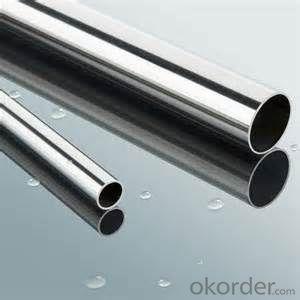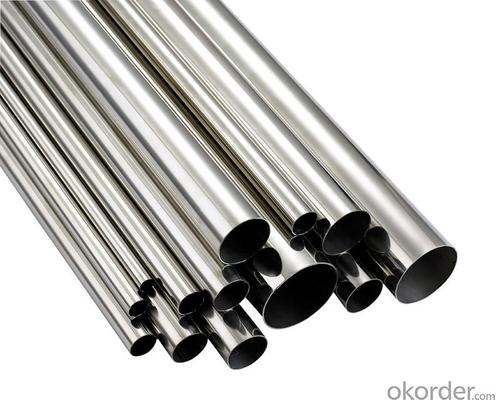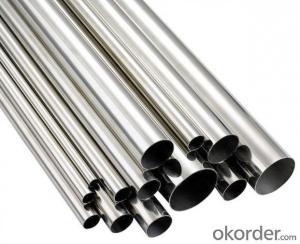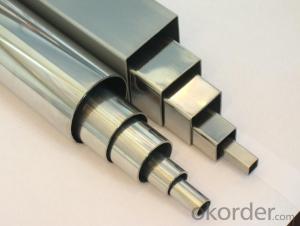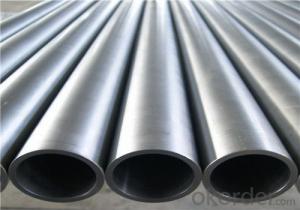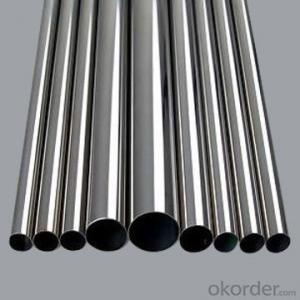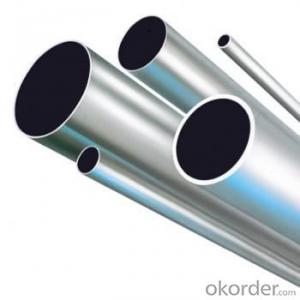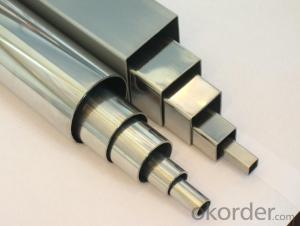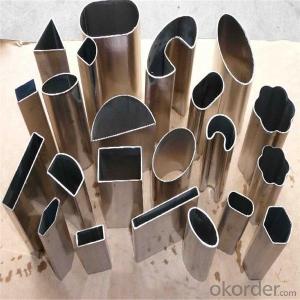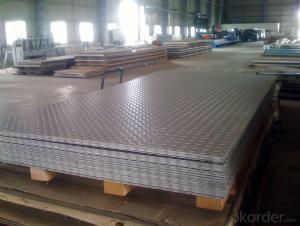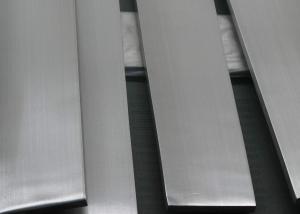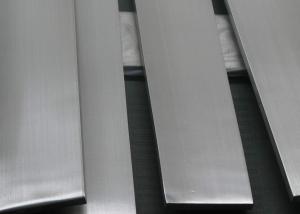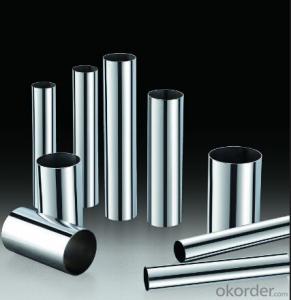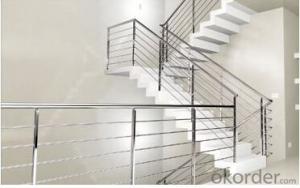STAINLESS STEEL PIPES 201 410 304 316 pipes
- Loading Port:
- China Main Port
- Payment Terms:
- TT OR LC
- Min Order Qty:
- -
- Supply Capability:
- -
OKorder Service Pledge
OKorder Financial Service
You Might Also Like
Description:
Stainless Steel Pipe
Material:
304 321 316 310
Packing:
In bundle
MOQ:
5 TONS
Comparison of standardized steels
| EN-standard Steel no. k.h.s DIN | EN-standard Steel name | SAE grade | UNS |
|---|---|---|---|
| 1.4109 | X65CrMo14 | 440A | S44002 |
| 1.4112 | X90CrMoV18 | 440B | S44003 |
| 1.4125 | X105CrMo17 | 440C | S44004 |
| | | 440F | S44020 |
| 1.4016 | X6Cr17 | 430 | S43000 |
| 1.4408 | G-X 6 CrNiMo 18-10 | 316 | |
| 1.4512 | X6CrTi12 | 409 | S40900 |
| | | 410 | S41000 |
| 1.4310 | X10CrNi18-8 | 301 | S30100 |
| 1.4318 | X2CrNiN18-7 | 301LN | |
| 1.4307 | X2CrNi18-9 | 304L | S30403 |
| 1.4306 | X2CrNi19-11 | 304L | S30403 |
| 1.4311 | X2CrNiN18-10 | 304LN | S30453 |
| 1.4301 | X5CrNi18-10 | 304 | S30400 |
| 1.4948 | X6CrNi18-11 | 304H | S30409 |
| 1.4303 | X5CrNi18-12 | 305 | S30500 |
| | X5CrNi30-9 | 312 | |
| 1.4541 | X6CrNiTi18-10 | 321 | S32100 |
| 1.4878 | X12CrNiTi18-9 | 321H | S32109 |
| 1.4404 | X2CrNiMo17-12-2 | 316L | S31603 |
| 1.4401 | X5CrNiMo17-12-2 | 316 | S31600 |
| 1.4406 | X2CrNiMoN17-12-2 | 316LN | S31653 |
| 1.4432 | X2CrNiMo17-12-3 | 316L | S31603 |
| 1.4435 | X2CrNiMo18-14-3 | 316L | S31603 |
| 1.4436 | X3CrNiMo17-13-3 | 316 | S31600 |
| 1.4571 | X6CrNiMoTi17-12-2 | 316Ti | S31635 |
| 1.4429 | X2CrNiMoN17-13-3 | 316LN | S31653 |
| 1.4438 | X2CrNiMo18-15-4 | 317L | S31703 |
| 1.4362 | X2CrNi23-4 | 2304 | S32304 |
| 1.4462 | X2CrNiMoN22-5-3 | 2205 | S31803/S32205 |
| 1.4539 | X1NiCrMoCu25-20-5 | 904L | N08904 |
| 1.4529 | X1NiCrMoCuN25-20-7 | | N08926 |
| 1.4547 | X1CrNiMoCuN20-18-7 | 254SMO | S31254
|
Stainless steel’s resistance to corrosion and staining, low maintenance and familiar lustre make it an ideal material for many applications. There are over 150 grades of stainless steel, of which fifteen are most commonly used. The alloy is milled into coils, sheets, plates, bars, wire, and tubing to be used in cookware, cutlery, household hardware, surgical instruments, major appliances, industrial equipment (for example, in sugar refineries) and as an automotive and aerospace structural alloy and construction material in large buildings. Storage tanks and tankers used to transport orange juice and other food are often made of stainless steel, because of its corrosion resistance. This also influences its use in commercial kitchens and food processing plants, as it can be steamcleaned and sterilized and does not need paint or other surface finishes.
Stainless steel is used for jewelry and watches with 316L being the type commonly used for such applications. It can be re-finished by any jeweler and will not oxidize or turn black.
Some firearms incorporate stainless steel components as an alternative to blued or parkerized steel. Some handgun models, such as the Smith & Wesson Model 60 and the Colt M1911 pistol, can be made entirely from stainless steel. This gives a high-luster finish similar in appearance to nickel plating. Unlike plating, the finish is not subject to flaking, peeling, wear-off from rubbing (as when repeatedly removed from a holster), or rust when scratched.
Stainless steel is used for buildings for both practical and aesthetic reasons. Stainless steel was in vogue during the art deco period. The most famous example of this is the upper portion of the Chrysler Building (pictured). Some diners and fast-food restaurants use large ornamental panels and stainless fixtures and furniture. Because of the durability of the material, many of these buildings retain their original appearance.
Type 316 stainless is used on the exterior of both the Petronas Twin Towers and the Jin Mao Building, two of the world's tallest skyscrapers.[17]
The Parliament House of Australia in Canberra has a stainless steel flagpole weighing over 220 tonnes (240 short tons).
The aeration building in the Edmonton Composting Facility, the size of 14 hockey rinks, is the largest stainless steel building in North America.
Cala Galdana Bridge in Minorca (Spain) was the first stainless steel road bridge.
Sant Fruitos Pedestrian Bridge (Catalonia, Spain), arch pedestrian bridge.
Padre Arrupe Bridge (Bilbao, Spain) links the Guggenheim museum to the University of Deusto.[18]
The Unisphere, constructed as the theme symbol of the 1964-5 World's Fair in New York City, is constructed of Type 304L stainless steel as a sphere with a diameter of 120 feet, or 36.57 meters.
The Gateway Arch (pictured) is clad entirely in stainless steel: 886 tons (804 metric tonnes) of 0.25 in (6.4 mm) plate, #3 finish, type 304 stainless steel.[19]
The United States Air Force Memorial has an austenitic stainless steel structural skin.
The Atomium in Brussels, Belgium was renovated with stainless-steel cladding in a renovation completed in 2006; previously the spheres and tubes of the structure were clad in aluminium.
The Cloud Gate sculpture by Anish Kapoor, in Chicago US.
The Sibelius monument in Helsinki, Finland, is made entirely of stainless steel tubes.
The Man of Steel (sculpture) under construction in Rotherham, England.
- Automotive bodies
The Allegheny Ludlum Corporation worked with Ford on various concept cars with stainless steel bodies from the 1930s through the 1970s, as demonstrations of the material's potential. The 1957 and 1958 Cadillac Eldorado Brougham had a stainless steel roof. In 1981 and 1982, the DeLorean DMC-12 production automobile used stainless steel body panels over a glass-reinforced plasticmonocoque. Intercity buses made by Motor Coach Industries are partially made of stainless steel. The aft body panel of the Porsche Cayman model (2-door coupe hatchback) is made of stainless steel. It was discovered during early body prototyping that conventional steel could not be formed without cracking (due to the many curves and angles in that automobile). Thus, Porsche was forced to use stainless steel on the Cayman.
- Passenger rail cars
Rail cars have commonly been manufactured using corrugated stainless steel panels (for additional structural strength). This was particularly popular during the 1960s and 1970s, but has since declined. One notable example was the early Pioneer Zephyr. Notable former manufacturers of stainless steel rolling stock included the Budd Company (USA), which has been licensed to Japan's Tokyu Car Corporation, and the Portuguese company Sorefame. Many railcars in the United States are still manufactured with stainless steel, unlike other countries who have shifted away.
- Aircraft
Budd also built an airplane, the Budd BB-1 Pioneer, of stainless steel tube and sheet, which is on display at the Franklin Institute.
The American Fleetwings Sea Birdamphibious aircraft of 1936 was also built using a spot-welded stainless steel hull.
The Bristol Aeroplane Company built the all-stainless steel Bristol 188 high-speed research aircraft, which first flew in 1963.
The use of stainless steel in mainstream aircraft is hindered by its excessive weight compared to other materials, such as aluminum.
- Jewelry
Valadium, a stainless steel and 12% nickel alloy is used to make class and military rings. Valadium is usually silver-toned, but can be electro-charged to give it a gold tone. The gold tone variety is known as Sun-lite Valadium
- Q: Can stainless steel pipes be used for underground drainage?
- Yes, stainless steel pipes can be used for underground drainage. Stainless steel is highly resistant to corrosion, making it a suitable material for underground applications where moisture and chemical exposure are common. Additionally, stainless steel pipes offer durability and strength, ensuring long-lasting performance in underground drainage systems.
- Q: How do stainless steel pipes compare to galvanized steel pipes?
- Stainless steel pipes and galvanized steel pipes are both commonly used in various industries and applications, but they have distinct differences in terms of their composition, properties, and performance. One of the primary differences between stainless steel and galvanized steel pipes is their composition. Stainless steel pipes are made from an alloy of iron with a minimum of 10.5% chromium content, which provides excellent corrosion resistance and durability. On the other hand, galvanized steel pipes are steel pipes that have been coated with a layer of zinc to protect them from corrosion. In terms of corrosion resistance, stainless steel pipes outperform galvanized steel pipes. The chromium content in stainless steel forms a passive layer of chromium oxide on the surface, which acts as a barrier against corrosion and rust. This makes stainless steel pipes highly resistant to pitting, crevice corrosion, and general corrosion caused by various substances and environmental factors. Galvanized steel pipes, although coated with zinc, are more susceptible to corrosion over time, especially when exposed to harsh conditions or corrosive substances. Another key difference lies in their durability and lifespan. Stainless steel pipes are known for their exceptional strength, toughness, and longevity. They can withstand high pressures, extreme temperatures, and mechanical stresses, making them suitable for demanding applications. Galvanized steel pipes, while durable, have a relatively shorter lifespan compared to stainless steel due to the eventual degradation of the zinc coating, which exposes the underlying steel to corrosion. In terms of maintenance, stainless steel pipes require minimal upkeep due to their inherent corrosion resistance. They are easy to clean and do not require regular painting or coating. On the other hand, galvanized steel pipes may require periodic inspection, maintenance, and re-coating to ensure prolonged protection against corrosion. Cost-wise, galvanized steel pipes are generally more economical upfront compared to stainless steel pipes. However, when considering the long-term benefits of stainless steel's corrosion resistance and durability, the overall cost-effectiveness of stainless steel pipes often surpasses that of galvanized steel pipes. In conclusion, stainless steel pipes offer superior corrosion resistance, durability, and longevity compared to galvanized steel pipes. While galvanized steel pipes may be more cost-effective upfront, stainless steel pipes provide long-term benefits and performance advantages, making them a preferred choice in many applications where corrosion resistance and durability are critical considerations.
- Q: Can stainless steel pipes be insulated with cork?
- Yes, stainless steel pipes can be insulated with cork. Cork insulation is commonly used as it provides excellent thermal insulation properties, is resistant to moisture, and has good fire-retardant qualities. It can effectively reduce heat loss or gain in stainless steel pipes, making it a suitable choice for insulation.
- Q: Can stainless steel pipes be used for cryogenic storage tanks?
- Yes, stainless steel pipes can be used for cryogenic storage tanks. Stainless steel is known for its high strength, corrosion resistance, and low thermal conductivity, making it suitable for handling extremely low temperatures required for cryogenic storage.
- Q: Can stainless steel pipes be used for underground sprinkler systems?
- Yes, stainless steel pipes can be used for underground sprinkler systems. Stainless steel pipes are highly resistant to corrosion and can withstand the harsh underground conditions, making them a durable and long-lasting option for sprinkler systems.
- Q: Are stainless steel pipes suitable for mining applications?
- Yes, stainless steel pipes are suitable for mining applications. Stainless steel is a durable and corrosion-resistant material that can withstand harsh and demanding environments commonly found in mining operations. It offers excellent resistance to corrosion, abrasion, and high temperatures, making it ideal for transporting various materials such as water, chemicals, and minerals in the mining industry. Stainless steel pipes are also known for their strength and ability to handle high-pressure conditions, which is crucial in mining applications. Additionally, stainless steel is non-reactive and does not release harmful substances into the materials being transported, ensuring the safety and purity of the mining processes. Overall, stainless steel pipes are a reliable and long-lasting choice for mining applications due to their durability, corrosion resistance, and ability to withstand extreme conditions.
- Q: Are stainless steel pipes suitable for brewery applications?
- Yes, stainless steel pipes are highly suitable for brewery applications. Stainless steel is a preferred material in the brewing industry due to its excellent corrosion resistance, durability, and hygienic properties. These pipes can withstand the harsh conditions of a brewery environment, including exposure to hot liquids and cleaning chemicals, without corroding or contaminating the beer. Stainless steel pipes also have a smooth surface, which helps prevent the buildup of bacteria and other contaminants, ensuring a high level of cleanliness and quality in the brewing process. Additionally, stainless steel is easy to clean and maintain, making it a practical choice for breweries. Overall, stainless steel pipes are a reliable and efficient option for brewery applications.
- Q: Are stainless steel pipes suitable for pharmaceutical clean rooms?
- Yes, stainless steel pipes are highly suitable for pharmaceutical clean rooms. They are preferred due to their excellent resistance to corrosion, durability, and ease of cleaning. Stainless steel pipes provide a hygienic and contaminant-free environment, making them ideal for pharmaceutical clean rooms where maintaining cleanliness and sterility is crucial.
- Q: What is the weight of stainless steel pipes?
- The weight of stainless steel pipes may differ based on factors such as their length, diameter, and wall thickness. Due to its high density, stainless steel pipes generally have a greater weight in comparison to pipes manufactured from alternative materials. Typically, the weight of stainless steel pipes is quantified in kilograms or pounds per meter or per foot. It is crucial to acknowledge that the weight can vary depending on the particular grade of stainless steel employed during the pipe fabrication process.
- Q: Can stainless steel pipes be used in chemical processing plants?
- Stainless steel pipes are indeed suitable for use in chemical processing plants. Their outstanding corrosion resistance makes them a favored choice for piping systems within these facilities. Given that chemical processing plants frequently handle corrosive substances and operate under high temperatures, stainless steel pipes are well-equipped to withstand such challenging environments. They exhibit resistance to various chemicals, including acids, bases, and chlorides, which are commonly encountered in chemical processing plants. Furthermore, stainless steel's smooth interior surface reduces the likelihood of corrosion and facilitates effortless cleaning and maintenance. All in all, stainless steel pipes provide a dependable and long-lasting solution for transporting chemicals in chemical processing plants.
Send your message to us
STAINLESS STEEL PIPES 201 410 304 316 pipes
- Loading Port:
- China Main Port
- Payment Terms:
- TT OR LC
- Min Order Qty:
- -
- Supply Capability:
- -
OKorder Service Pledge
OKorder Financial Service
Similar products
Hot products
Hot Searches
Related keywords

